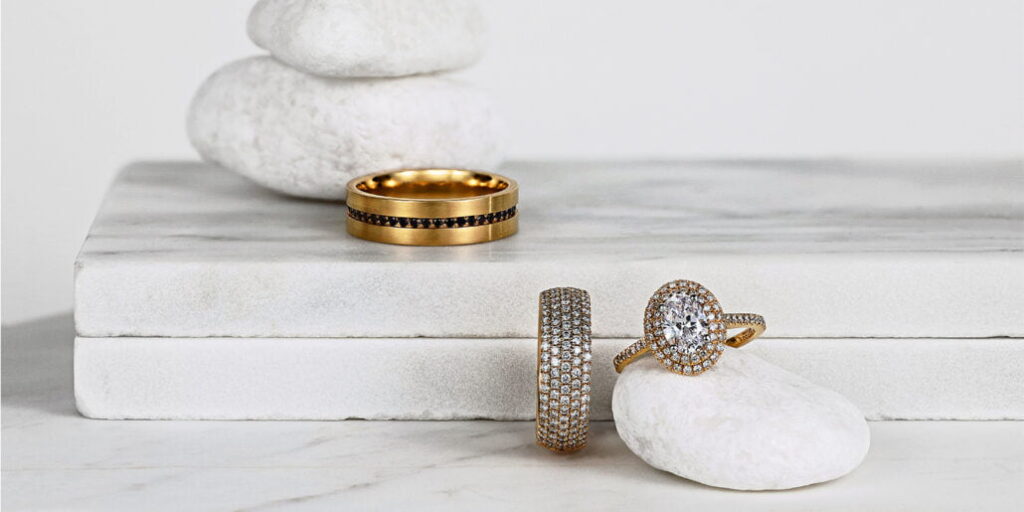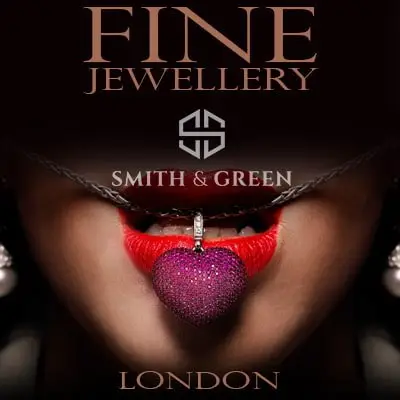Choosing a wedding ring is a significant decision that requires careful consideration. With so many styles, materials, and designs available, it can be overwhelming to find the perfect ring to symbolize your love and commitment.
This article will guide you through the process of selecting a wedding ring, from setting a budget and considering your lifestyle to researching engagement rings and short wedding dresses for inspiration.
Set a Budget
Before shopping for wedding rings, discuss your budget with your partner to help narrow down choices and prioritize aspects like diamond quality, metal type, and overall design. The average cost of an engagement ring is around $6,500 to $7,000 (2021-2022), while the average woman’s wedding ring costs around $1,400 and the average man’s wedding band is around $560. However, it’s essential to avoid spending beyond your means and going into debt for an engagement ring.
The cost of an engagement ring depends on several factors, including:
- The 4Cs (cut, clarity, carat, and color)
- Details like a halo or stones in the band
- The type of metal chosen
For wedding rings, material, weight, and width of the band significantly influence the cost. If the wedding ring has diamonds or other stones, prices will be based on the 4 C’s of diamonds: cut, carat, color, and clarity.
To save money on an engagement ring, consider:
- Ditching the diamond and considering alternatives like white sapphire, moissanite, or cubic zirconia
- Knowing your settings; certain settings can be expensive and influence the size of the center stone
- Manipulating the 4Cs to work within your budget
- Going the antique route for hidden color and a romantic touch
It’s generally better to pay for rings with money already saved plus what can be reasonably saved before the bill is due, rather than going into debt.. Comparing prices, shopping around, bundling purchases, and taking advantage of sales can help manage costs. Remember, the amount spent on a wedding ring does not determine the happiness or success of a marriage.
Consider Your Lifestyle

When choosing a wedding ring, it’s crucial to consider your lifestyle and daily activities. If you have an active lifestyle or work in a demanding environment, opt for a simple, solid gold design or a low-profile ring that can withstand wear and tear. Factors like durability, comfort, and practicality should be prioritized to ensure your ring suits your everyday life.
Consider the following when selecting a wedding ring based on your lifestyle:
- Profession: If you work in a job that requires frequent hand use, lifting, or carrying, choose a wider band style (2mm+) to better withstand repeated pressure. For those working in environments that require regular latex glove use, such as labs or medical facilities, a solitaire style with a low-set center stone is recommended to prevent damage to small pavé prongs and alignment issues.
- Hobbies and Activities: Active individuals may benefit from silicone or alternative-metal rings for certain activities. Thin band engagement rings (less than 1.8mm width) are more susceptible to wear issues and may require cautious wear habits, such as removing the ring for most activities. Eternity bands, where diamonds go all the way around the finger, can put constant pressure and impact on the stones and prongs during daily wear. A half-eternity or three-quarter style band can be a beautiful and practical alternative.
- Maintenance: Low-maintenance rings are ideal for busy lifestyles. Engraved rings or those with intricate designs can be difficult to clean and maintain. Regular inspection and preventative maintenance, such as retipping worn prongs, are necessary to prevent the loss of stones from the band.
Research and Find Inspiration
When searching for the perfect wedding ring, it’s essential to explore various sources for inspiration. Browse online platforms like Pinterest to discover a wide range of engagement ring styles, including popular choices such as:
- Diamond rings (round and solitaire)
- Halo engagement rings (center diamond surrounded by smaller diamonds)
- Rose gold halo pavé engagement rings
- Vintage and unique engagement rings
Websites like Michael M, VRAI, and Ken & Dana Design offer diverse collections of engagement rings in different metals, styles, and eras. Michael M’s Crown Collection features hidden halo designs compatible with any cut, color, or style of ring. VRAI provides a guide on engagement ring styles, including classic, vintage, modern, and Art Deco, while Ken & Dana Design specializes in vintage-inspired rings from the Art Deco, Victorian, and Edwardian eras.
When researching wedding rings, consider your personal style and comfort. Explore options such as:
- Simple metal bands
- Rings with diamonds or other gemstones
- Thin or thick bands
- Traditional or trendy designs
- Custom wedding rings
Compare prices, quality, and options from different jewelers to ensure you’re getting a fair deal. Read customer reviews and ratings to gauge other customers’ experiences. The American Gem Society (AGS) offers a “Find a Jeweler” search tool to help you locate qualified jewelers in your area who adhere to the highest ethical and professional standards.
Understand Sizing and Comfort
When choosing a wedding ring, it’s crucial to prioritize comfort and ensure a proper fit. Make time to try different styles in person to understand what feels most comfortable on your finger. A well-fitting ring should slide over your knuckle with a little friction and fit snugly on your finger without being too tight.
Consider your finger shape when selecting a ring size:
- If you have wide fingers and a small knuckle, choose a size that fits snugly around your finger to keep the ring in place without cutting off circulation.
- If you have large knuckles but slim fingers, opt for the smallest size that you can slide down over your knuckle and remove without discomfort.
Proper ring fit is essential for long-term comfort. A ring that is too tight may be worn less often due to discomfort, while a loose ring is at risk of slipping off or getting lost. Keep in mind that finger size can fluctuate throughout the day due to factors like movement, diet, and water retention. For the most accurate sizing, measure your finger in the mid-afternoon, after lunch, when your finger size is most stable.
Work with an experienced jeweler for precise ring size measurement, and avoid relying solely on do-it-yourself methods found online. A professional should use various tools and methods to determine the most comfortable size, and it’s beneficial to seek a second opinion from another professional for accuracy]. When fitting a ring, consider the following:
- The ring should slide over the knuckles with ease but require a bit more effort to come off.
- There should be a small space between the ring and finger when pushing it up from underneath.
- The ring should fit snugly at the base of the finger without bulging or leaving indent marks.
- Individuals with enlarged knuckles may need a looser fit at the base of the finger, while those with smaller knuckles may require a tighter fit.
Comfort Fit rings have a domed interior that minimizes contact between the finger and the ring’s surface. When purchasing a Comfort Fit ring, it’s recommended to order half a size smaller than your normal ring size. Most contemporary metal rings (tungsten, titanium, cobalt, stainless steel, etc.) come in full and 1/2 sizes, while precious metal rings (gold, platinum, palladium) typically come in 1/4 sizes. To ensure the correct size, many sellers send a sizing ring before crafting the actual ring. Choose rings that are easy to resize, as rings with diamonds all across the band can be difficult to adjust.
Trust Your Jeweler
When shopping for wedding rings, trust your jeweler to guide you through the process. Look for a reputable jeweler with experience in wedding rings and various design options. Consider the following when selecting a jeweler:
- Reputation: Choose a jeweler with a good reputation, which can be determined by reading online reviews or asking for recommendations from friends and family. A jeweler’s reputation is worth more than any diamond they could potentially swap out.
- Expertise: Ask to meet the store’s expert jewelers and gemologists. Any reputable jewelry store should have certified specialists, such as Graduate Gemologists (GG), on staff to handle any questions you may have. Look for jewelers with impeccable credentials from international gemological schools like GIA.
- Certification: When buying a diamond, ask for certification from a reputable gemological laboratory such as the GIA or the IGI. Review the certification to understand the diamond’s quality. Professional jewelers worldwide provide an independent diamond grading report with their fine diamonds, and the most trusted and accurate reports come from GIA, the creator of the 4Cs diamond grading standard.
When selecting a diamond, consider going under-size (e.g., 0.95 carats instead of 1 carat) to save money, and choose clarity and color that look clean to the naked eye. Choose a setting and metal for an engagement ring based on skin tone and stone color. Platinum is expensive but beautiful, while white gold is a more affordable alternative.
To care for your wedding rings, remove them during activities like gardening, rock climbing, sailing, or when using harsh chemicals. Clean them regularly, get them inspected by a professional jeweler at least once a year, and consider getting insurance for your wedding rings.
Conclusion
Choosing the perfect wedding ring is a deeply personal and meaningful decision that requires careful consideration of various factors. By setting a realistic budget, considering your lifestyle, researching inspiration, understanding sizing and comfort, and trusting a reputable jeweler, you can navigate the selection process with confidence. Remember that the true significance of a wedding ring lies in the love and commitment it symbolizes, rather than its material value.
As you embark on this exciting journey, take the time to explore your options, communicate openly with your partner, and prioritize what matters most to you both. With thoughtful planning and a focus on what truly resonates with your unique love story, you’ll find the perfect wedding ring to cherish for a lifetime.
















